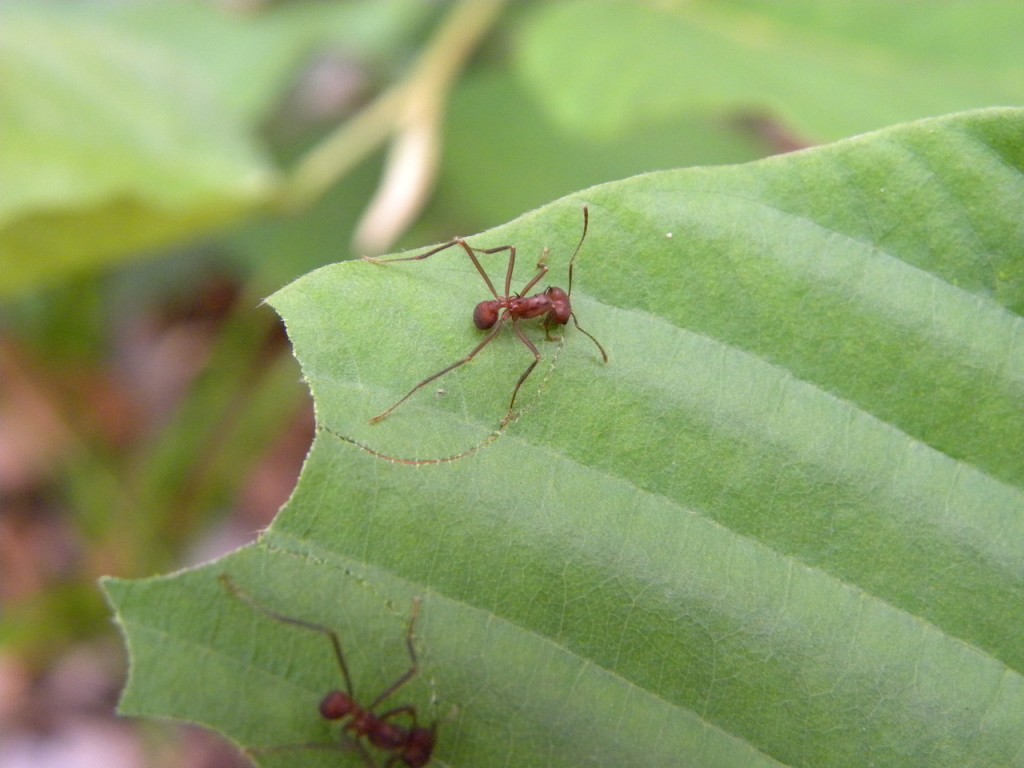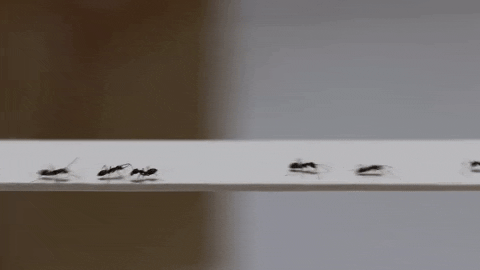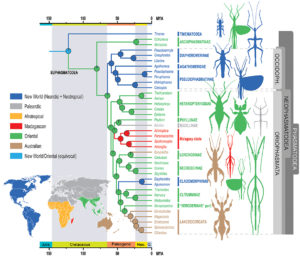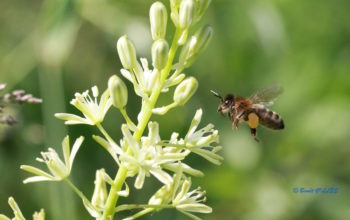Mushroom ants have the particularity of feeding exclusively on a Basidiomycete fungus, which they grow on a substrate fed by the collection of pieces of plants (leaves, flowers, fruits) (video at the bottom of page). The two species have maintained a symbiotic mutualist relationship of total interdependence in co-evolution for nearly 67 million years.
It appears that this substrate can be parasitized by another fungus of the genus Escovopsis. Despite the discovery of the parasite 25 years ago, the relationships between this procession of species remain almost unknown.
This is why a team led by Brazilian scientist Lucas A. Meirelles (California Institute of Technology) undertook one of the most important studies concerning this ant parasite. She wanted to understand the evolutionary and phylogenetic relationships between ants, Basidiomycetes and parasitic fungi. After years of collection across North and South America, molecular and genetic analyses, and microscopic observations, his results have just been published.
They first allowed the identification of 61 new strains of this parasitic fungus, then to reveal, against all expectations, the general aspect of this parasitism.
caption id=”attachment_676″ align=”alignright” width=”310″] Atta workers growing the fungus Basidiomycete (Source : Alexander Wild)[/caption]
Atta workers growing the fungus Basidiomycete (Source : Alexander Wild)[/caption]
Mushroom ants are 250 species divided into 16 genera. They maintain the most complex and fascinating symbiotic relationships in nature. The degree of morphological, physiological and behavioural co-adaptation is such that the two species cannot survive alone: mutualism symbiotic (to discover more, read these articles Atts of the genus Atta and Adaptation symbiotic ).
For these reasons, these insects are strongly studied in order to understand the evolutionary, adaptive and genetic mechanisms at the origin of the establishment of such symbiotic relationship. Parasitic fungi have been able to integrate and exploit this mutualism. Certain genera such as Trichoderma, Syncephalastrum and Fusarium, are cosmopolitan and occur outside the colonies of fungal ants. However, the parasitic fungus of the genus Escovopsis is specifically related to these ants.
The early studies suggested that each genus and line of ants contained a specific parasite line. For example, 3 populations geographically distant from a Trachymyrmex species (Panama, Ecuador, Trinidad) would be infected by 3 monophyletic strains (from the same common ancestor) de Escovopsis. More generally, scientists thought that each type of ants was associated with a specific line of the parasite, this specificity being acquired by co-evolution.
It was to test these hypotheses and provide knowledge on the diversity of Escovopsis in South America (cradle of diversity in mushroom ants) that the team of scientists began its work in the early 2000s.
Search initially consisted of <!More–> Collect parasitic fungi from all species of ants of the genera Trachymyrmex, Sericomyrmex, Acromyrmex and Atta (genera that possess the highest degree of symbiotic mutualism complexity) throughout South America, then to compare, by molecular, genetic and microscopic analyses, the strains of Escovopsis between them and between the different species of ants : phylogenetic tree.

The main results, surprising and unexpected, show, after having identified 61 different strains of Escovopsis, an absence of specificity of infection of the parasite within the mushroom ants. The same ant species can thus be parasitized by distinct strains of Escovopsis, and the same strain of the parasite infects several genera of ants.
For example, in a colony of the species Acromyrmex molestans have been identified 3 strains of the parasite : E. moelleri and E. microspora on top of the Basidiomycete substrate and E. moelleri and E. lentecrescens below.
Scientists propose a hypothesis to interpret the phylogenetic tree obtained (Figure 1 at the bottom of the page):
- Some strains (clades) of Escovopsis would have a general pathogenic potential (clade I, II, V and VII), capable of infecting several kinds of fungal ants whatever their degree of matching. The other clades of Escovopsis (clades IV, VI and VIII), as for them, would be more specific to genera or populations of these ants, or specific to geographical regions.
While the mechanisms of transmission and dispersal between colonies of ants are still unknown, it is possible that a generalist vector may be able to transmit the parasite between nests of phylogenetically distant ants (clades I, II, V and VII), others would be confined to more specific clades (clades IV, VI and VIII).
Other explanations can be proposed
- The rare (least represented) strains of Escovopsis could be adapted to specific ecological conditions in the regions where they are found.
- Generalist strains of Escovopsis would have been selected to benefit from a wide range of hosts allowing them to disperse in the environment.
- Rare strains of Escovopsis would have evolved to bypass defensive barriers of specific hosts only.
An interesting case concerns Acromyrmex octospinosus in Guadeloupe. This species, after being introduced, has become invasive. Surprisingly, Escovopsis has been found in colonies on the island.
The possible hypotheses to explain this presence are
- Escovopsis being present in the introduced colony, the parasite would not be lethal because the colony survived and could multiply. Escovopsis would be transmitted by queens during swarming vertical transmission.
- Escovopsis would disperse in the environment over very long distances to reach island regions.
This research must continue to obtain more data on the evolutionary history between Escovopsis and the fungal ants it parasitizes. The relationships between these species appear to be much more complex than early studies presupposed. For example, Escovopsis could be a general pathogen that would have specialized during evolution to these ants, but would still have the ability to spread within a group of phylogenetically distant species.
In addition, further investigations should be conducted on the life cycle of this parasite, for example to determine the transmission mechanisms.
This pest research Escovopsis is part of a biological control program and offers potential as a control agent against the species Atta texana which causes significant damage in Texas and Louisiana on citrus, peach and other fruit crops.
caption id=”attachment_2471″ align=”aligncenter” width=”668″] Figure 1 : Phylogenetic tree of the different Escovopsis strains associated with the ants lines they parasitize (Source : Meirelles et al., 2015)[/caption]
Figure 1 : Phylogenetic tree of the different Escovopsis strains associated with the ants lines they parasitize (Source : Meirelles et al., 2015)[/caption]
Video of ants of the genus Atta bringing pieces of plants back to the colony : Soberania National Park – Panama (Source : Benoît GILLES)
Source :
– Meilleres L.A. Solomon S.E.; Bacci Jr. M. ; Wright A.M. ; Mueller U.G. & Rodrigues A. (2015) : Shared Escovopsis parasites between leaf-cutting and non-leaf-cutting ants in the higher attine fungus-growing ant symbiosis. The Royal Society Open Science, 2-12 (lien)
Recommendations for books on this theme :
– Les Ants : Behavior, Social Organization and Evolution (Luc Passera and Serge Aron – Edition : Canadian Science Publishing – 480 pages – January 2005)
– The world of ants (Rémy Chauvin – Edition du Rocher – 285 pages – October 2, 2003)
– The extraordinary world of ants (Luc Passera – Edition : Fayard – 235 pages – March 13, 2008)
– Ant Ecology (Catherine Parr ; Kirsti Abbott & Lori Lach – Edition : Oxford University press – 2010)
– Mutualism : Ants and their Insect Partners (Bernhard Stadler & Tony Dixon – Edition : Cambridge University Press – 248 pages – April 7, 2008)
– The Leafcutter Ants – Civilization by Instinct (Bert Hölldobler & ; Edward O’Wilson – Edition W. W. Norton & ; Company – 192 pages – 26 octobre 2010)
>>.
– The Lives of Ants (Laurent keller & ; Elisabeth Gordon – Edition OUP Oxford – 273 pages – 26 février 2009)/p>>>.
>>
.
>>
>>





